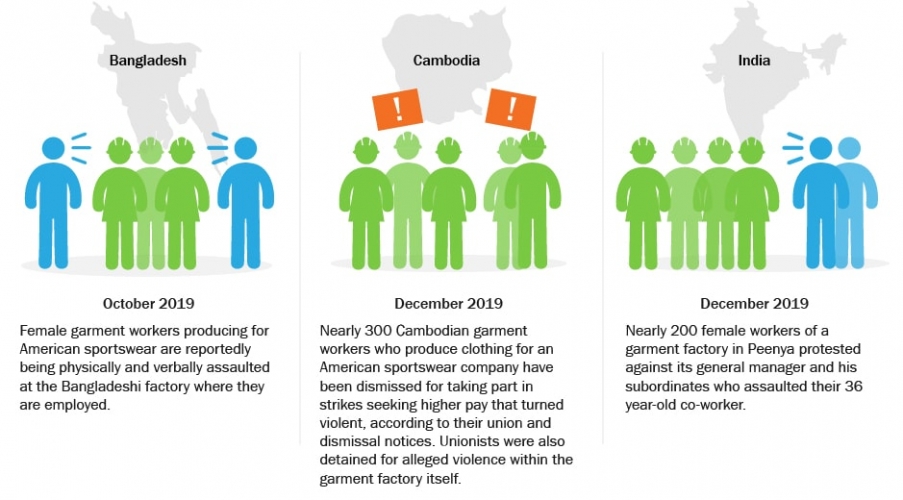How data science can help your business to effectively manage supply chain risk
Consumers and stakeholders are increasingly demanding that brands evidence traceability and transparency in their supply chain. These demands translate into requests to publish supplier lists and product origins. When this information is not published directly by brands or retailers it can often be obtained from publicly available sources e.g. social media, customs records, industry initiatives etc. The wide-ranging availability of such data in the public domain increases the reputational risk for companies from media and NGO campaigns. Innovative data science techniques can help companies proactively identify these risks and take action as part of their ESG impact.
Data on company supply chains is already “out there”
As of December 2019, the Open Apparel Registry publishes details of the supply chains for more than 60+ companies / apparel associations and a total of 23,000+ suppliers around the world. This includes lists provided and managed directly by companies, and also the data independently retrieved from company websites. As transparency becomes a business, those companies that do not disclose sourcing details are increasingly likely to be singled out in the media and risk a gradual deterioration of consumer trust.
But disclosing supplier names may mean exposing problematic violations and unethical business practices. With access to supplier names, consumers, NGOs and media are now just a few clicks away from (a) googling factory names (b) finding news about worker wage underpayment, health and safety hazards, or allegations of corruption, and; (c) attributing these to the brand or retailer.
Such information is readily available even on companies that may have been more secretive, as other stakeholders contribute to the trend by disclosing data. For instance, the United States Freedom of Information Act requires public administration data to be publicly available. This includes customs trade data which can reveal business ties between importers, including brands and retailers, and suppliers that have been blacklisted by compliance authorities.
These trends require companies to adopt more innovative strategies to manage risk in their supply chain. While audits are still necessary for monitoring compliance with codes of conduct, analytics and data science are fast becoming a complement to such in-person field visits. Data science helps companies to implement a more continuous and remote monitoring of supply chains, enabling them to act fast in the face of crises e.g. labor tensions or worker safety issues.
Integrating data science into everyday risk management
Responsible sourcing leaders should consider the following three key steps that leverage data to improve their supply chain risk visibility and management:
1. Build capacity: Companies need the right capacity in place to leverage data. This means putting together an analytics team or working with partners that have both technical skills and appropriate backgrounds in sustainability and sourcing. Brands that are recruiting data scientists as they build an in-house team need to be aware that technical skills alone will not build effective products for risk identification or management. Data scientists without some background in sustainability may fail to assess biases in the data or understand how relevant events may contribute to risk in the supply chain.
2. Get access to data: Access to web and webscraping technology can help brands monitor issues and developments in the supply chain.
- News and Web APIs – services that search and retrieve web information – are able to gather traditional and non-traditional media (e.g. blogs, company press releases and quarterly reports, other online reports, social media messaging).
- Web scraping technology can help companies monitor the presence of specific news on websites or platforms that collect information about risk or companies’ compliance violations. Users interested in scraping information must check that websites do not specifically forbid scraping activities on their pages.
- Access to third party platforms such as those offering customs trade data or supply chain intelligence can improve the client’s capacity to trace products and business relationships along the supply chain.
3. Integrate data into your processes and systems: Data can be overwhelming, and it may be challenging to find direct applications for everyday business use. Responsible sourcing and analytics teams need to plan how the information will be gathered, processed and integrated into existing responsible sourcing workflows for action. This may include (a) streamlining the flow of information to only relevant, categorized and actionable data points (b) integrate it into existing risk management tools currently used by the responsible sourcing team such as ELEVATE’s EiQ. With the right intelligence in hand, responsible sourcing teams can manage risk effectively e.g. investigating supplier violations of workers’ rights as soon as they are reported by local news/blogs or plan the allocation of specialized audits (foreign migrant worker assessment, environmental checklist) based on violation trends as evidenced by the harvested data.
ELEVATE Online Risk Scan
The ELEVATE team (with support and feedback from our customers) has developed the ELEVATE Online Risk Scan to help clients monitor risk in their supply chain. This algorithm (a) leverages powerful, complementary web APIs and webscraping technology, in order to (b) collect and identify news and posts related to compliance risk and unethical business behaviors across the world. In addition, the tool scans through key websites and factory lists to verify whether a company can be indirectly linked to suppliers blacklisted by the private sector or industry bodies or are associated with significant risk e.g. forced labor in the cotton sector.
| CASE STUDY: Screening a well-known apparel brand using public domain data
Based on the Open Apparel Registry data, ELEVATE ran a quick screen of the supplier base of a well-known apparel group. The screen highlighted significant risks in the supply chain. We counted 23 news and posts in 2019 that were related to significant risk in the supply chain. Most of these violations – spanning across the globe – relate to worker protests in response to physical abuses by factory managers, lack of wage payment and detention of trade union representatives. |
 |
The future is now
Consumers and stakeholders expect buyers to embrace transparency in their operations, and companies need to adapt to be able to meet these demands. Data provides an opportunity for companies to monitor conditions in the supply chain to act fast in face of crisis, and to strengthen prevention going forward. Given the high value at stake, companies need to embark now to adopt innovative, data-driven approaches to monitor the supply chain. Brands that are serious about digital transformation realize that technology and data are vital tools to manage risk and improve working conditions in their supply chain.
Ready to adopt innovative data science techniques to proactively identify and manage supply chain risk? Want to know more about the ELEVATE Online Risk Scan?
Contact ELEVATE – tell us about your data challenges
These blogs are written by ELEVATE staff members or associates and the views and opinions expressed are not necessarily those of ELEVATE.
About the author
